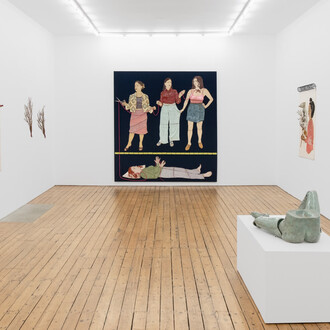My thought has always been the result of an awareness for people and the land.
(Manifesto ainda que tardio, 1976)
The Approach is proud to present the first solo exhibition in the UK of one of the key figures of 20th-century Brazilian art and Afro-Atlantic histories: Rubem Valentim (1922 – 1991) was among the first generation of artists who were openly inspired by the sacred symbology of Afro-Brazilian religions and adopted a syncretic approach within their respective practices. Along the likes of Agnaldo Manoel dos Santos, Carybé and Mestre Didi, who shared this common vision, Valentim was instrumental in introducing the wider Brazilian population to the visual vocabulary of these religions and the cultural significance of Northeast Brazil. The show features the artist’s signographic paintings and votive sculptures conceived during the years 1972 to 1990.
Following the widespread miscegenation and introduction of Catholicism during Portuguese colonial rule in Brazil, the enslaved West African peoples and their descendants safeguarded their traditions by blending elements of their own religions with that of the colonists’ belief system. Candomblé is one notable Afro- Brazilian religion that was a direct offspring of this syncretism and gained strong foothold in Valentim’s birth region of Bahia.
A self-taught artist, Valentim began to paint in 1946 during which time he also obtained a degree in dentistry. Eventually abandoning the latter profession, the artist quickly became an active figure and involved in Bahia’s artistic and literary circles. Looking outward, during this time the artist also drew great inspiration from the works of Paul Cézanne, Paul Klee, and Joan Miró. The following decade proved to be a significant period for Valentim as during this time he produced increasingly abstract works which fortuitously also marked the start of his itineration from his hometown Salvador to Rio de Janeiro. He later on settled in Rome and London, before moving to Brasília, the last of which was deemed a necessary and foundational step for artists of his generation.
From the outset Valentim made a conscious decision to eschew the global artistic trends, introduced into Brazil’s artistic milieu by way of abstraction and concretism movements, in favour of the local folklore and religions of his hometown. The artist adopted the European artistic languages—which dominated the Brazilian art production scene during the 1950s and 60s—only then to pool and transmute various elements of Afro-Atlantic symbols into a complex rubric of his own. The drawings and diagrams that the artist created mostly referenced the orishas (spirits in Latin American folklore), such as Shango’s double-edged axe, Oshoosi’s arrow, and Osanyin’s staff. Contrary to the avant-gardists who used constructivism and abstraction as neutralising compositional tools, Valentim imbued his geometric abstractions with mysticism and religious symbols of Candomblé and Umbanda. Creating and recreating the form and meaning of the sacred within this symbolic universe.
In his ‘A manifesto, albeit late’ (1976), Valentim wrote of his desire to produce a universal visual repertoire based on regional traits, one that truly expressed Brazil’s cultural complexities and historical miscegenation. The manifesto also lays bare on the one hand the artist’s proclivities for exchanges amongst cultures, and on the other hand his strong opposition towards colonialism and servility to international styles. Insofar as Valentim’s manifesto possesses a regional, and even personal character, his writings also appear to garner a more universal audience. The delay to which the artist refers to in the title of his manifesto, was perhaps an innuendo given its apt and timely probe into the artistic processes that had up until then been marginalised and rendered invisible. In a sense, the phrase ainda que tardio [albeit late] indicates the artist’s awareness of a delay in lending credence to the Africa-descended population in the Brazilian society—a noble and socially significant undertaking that is now as urgent as it ever was.
Valentim lived in Rio de Janeiro from 1957 to 1963, where he became assistant professor to Carlos Cavalcanti, teaching Art History at Instituto de Belas Artes. In 1963, he moved to Rome after being awarded a travel prize from Salão Nacional de Arte Moderna (SNAM). In 1966, Valentim took part in the World Festival of Black Arts, in Dakar. Upon his return to Brazil, he moved to Brasília, where he gave painting lessons at Instituto de Artes da Universidade de Brasília (UnB). In 1972, the artist produced a marble mural for the government headquarters in Brasília. In 1979, Valentim created a large-scale concrete sculpture installed at Praça da Sé in São Paulo and defined it as the ‘Syncretic Structure of Afro-Brazilian Culture’. In the same year, he was selected by a group of critics to produce five medallions in gold, silver and bronze as Afro-Brazilian symbols for an important public building. In 1998, Museu de Arte Moderna da Bahia (MAM/BA) opened the Rubem Valentim Special Room at its Sculpture Park. In 2018, MASP presented a major retrospective of his work.
















